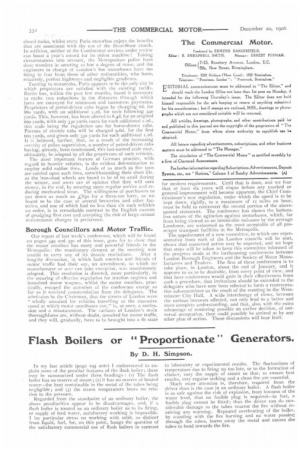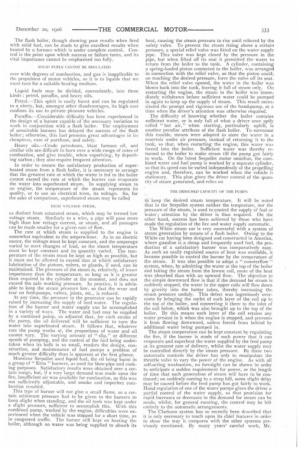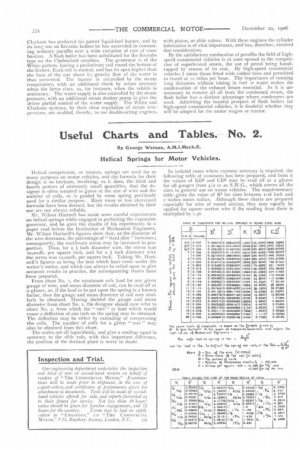Flash Boilers or " Proportionate " Generators.
Page 2

Page 3

Page 4

If you've noticed an error in this article please click here to report it so we can fix it.
By D. H. Simpson.
In my last article (page 295 ante) I endeavoured to explain some of the peculiar features of the flash boiler; these may be summarised under three headings : (1) The flash boiler has no reserve of steam ; (2) it has no reserve of heated water—the heat containable in the metal of the tubes being negligible; and (3) the steam temperature bears no relation to the pressure.
Regarded from the standpoint of an ordinary boiler, the above peculiarities appear to be disadvantages, and, if a flash boiler is treated as an ordinary boiler as to its firing, or supply of feed water, satisfactory working is impossible. I lay particular stress on working with solid, as distinct from liquid, fuel, for, on this point, hangs the question of the satisfactory commercial use of flash boilers in contrast to laboratory or experimental results. The fluctuations of temperature due to firing up too late, or to the formation of clinker, vary the supply of steam so that, to ensure best results, very regular stoking and a clean fire are essential.
Much more attention is, therefore, required from the driver than is the case in an ordinary boiler. A flash boiler is so safe against the risk of explosion, from lowness of the water level, that no fusible plug is required—in fact, a fusible plug cannot be fitted; thus the driver can do considerable damage to the tubes nearest the fire without receiving any warning. Repeated overheating of the boiler, by standing with the fire burning and no water passing through the tubes, burns away the metal and causes the tubes to bend towards the fire. The flash boiler, though showing poor results when fired with solid fuel, can be made to give excellent results when heated by a furnace which is under complete control. Control is the point upon which success or failure turns, and its vital importance cannot be emphasised too fully.
SOI.ID FUELS CANNOT BE REGULATED
over wide degrees of combustion, and gas is inapplicable to the propulsion of motor vehicles, so it is to liquids that we must turn for a suitable heating medium.
Liquid fuels may be divided, conveniently, into three kinds : petrol, paraffin, and heavy oils.
Petrol.—This spirit is easily burnt and can be regulated to a nicety, but, amongst other disadvantages, its high cost confines its use to private pleasure vehicles.
Paraffin.—Considerable difficulty has been experienced in the design of a burner capable of the necessary variation to work in conjunction with a flash boiler. The employment of unsuitable burners has delayed the success of the flash boiler ; otherwise, this fuel presents great advantages in its cheapness, ease of purchase, and safety.
Heavy oils.—Crude petroleum, blast furnace oil, and similar oils are difficult to burn over a wide range of rates of combustion, and give trouble, when vaporising, by depositing carbon ; they also require frequent attention.
In order to ensure the satisfactory production of superheated steam from a flash boiler, it is necessary to arrange that the greatest rate at which the water is fed to the boiler cannot exceed the rate at which the burner can evaporate the water into superheated steam. In supplying steam to an engine, the temperature of the steam represents its quality, or to use an electrical term, its voltage. So, for the sake of comparison, superheated steam may be called
HIGH VOLTAGE STEAM,
as distinct from saturated steam, which may be termed low voltage steam. Similarly to a wire, a pipe will pass more high than low voltage current, or steam, and all passages can be made smaller for a given rate of flow. The rate at which steam is supplied to the engine is somewhat equivalent to the ampere-hour. As in an electric motor, the voltage must be kept constant, and the amperage varied to meet changes of load, so the steam temperature must be kept constant and its quantity varied. The temperature of the steam must be kept as high as possible, but it must not be allowed to exceed that at which satisfactory lubrication of the pistons, valves, or glands, if used, can be maintained. The pressure of the steam is, relatively, of lesser importance than the temperature, so long as it is greater than required in the cylinder at the moment, and does not exceed the safe working pressure. In practice, it is advisable to keep the steam pressure low, so that the wear and tear on feed-pumps, valves, joints, etc., is reduced. At any time, the pressure in the generator can be rapidly raised by increasing the supply of feed water. The regulation of the burner and water supply can be accomplished in a variety of ways. The water and fuel may be supplied by a combined pump, so adjusted that, for each stroke of the pump, the oil delivered will be sufficient to turn the water into superheated steam. It follows that, whatever rate the pump works at, the proportions of water and oil cannot vary. The varying amount of "slip," at different speeds of pumping, and the control of the fuel being undertaken when its bulk is so small, renders the design, construction, and maintenance of fuel pumps a problem of much greater difficulty than is apparent at the first glance. Monsieur Serpollet used liquid fuel, the oil being burnt in a group of" Etna "burners, as used for blow-pipe and cooking purposes. Satisfactory results were obtained over a certain range, but, if a very large demand was made upon the fire, insufficient air was available for combustion, as this was not sufficiently adjustable, and smoke and imperfect combustion resulted.
This type of burner will not give a small flame, so a certain minimum pressure had to be given to the burners to keep alight when standing, and the oil tank was kept under a slight pressure, sufficient to accomplish this. With this combined pump, worked by the engine, difficulties were experienced when the vehicle was stopped for a short time, as in congested traffic. The burner still kept on heating the boiler, although no water was being supplied to absorb its heat, causing the steam pressure to rise until relieved by the safety valve. To prevent the steam rising above a certain pressure, a special relief valve was fitted on the water supply pipe. This valve was kept closed by the pressure in the pipe, but when lifted off its seat it permitted the water to return from the boiler to the tank. A cylinder, containing a spring-loaded piston connected to the boiler, was arranged in connection with the relief valve, so that the piston could, on reaching the desired pressure, force the valve off its seat. When the relief valve opened, the water in the boiler was blown back into the tank, leaving it full of steam only. On restarting the engine, the steam in the boiler was immediately withdrawn before sufficient water could be pumped in again to keep up the supply of steam. This result necessitated the prompt and vigorous use of the hand-pump, at a time when the driver's attention was otherwise required.
The difficulty of knowing whether the boiler contains sufficient water, or is only full of what a driver once aptly called " hot air," when starting, particularly uphill, is another peculiar attribute of the flash boiler. To surmount this trouble, means were adopted to store the water in a reservoir under air pressure, instead of returning it to the tank, so that, when restarting the engine, this water was forced into the boiler. Sufficient water was thereby returned to the boiler to make steam till the pump got fairly to work. On the latest Serpollet motor omnibus, the combined water and fuel pump is worked by a separate cylinder, so that its speed can be varied independently of the propelling engine and, therefore, can be worked when the vehicle is stationary. This plan gives the driver control of the quantity of steam generated, and relies on
THE DESIGNED CAPACITY OF THE PUMPS
to keep the desired steam temperature. It will be noted that in the Serpollet system neither the temprature, nor the pressure of the steam, is used to control the supply of fuel or water ; attention by the driver is thus required. On the other hand, success has been achieved by those who have made the regulation of the fire and water supply automatic.
The White steam car is very successful with a system of steam generation by means of a flash boiler. Owing to the White car having been designed and constructed in America, where gasoline is a cheap and frequently used fuel, the production of a satisfactory burner was comparatively easy. As such an easily regulated source of heat was available, it became possible to control the burner by the temperature of the steam. It was also possible to adopt a " counterflow " system, when, by admitting the water at the top of the boiler and taking the steam from the lowest coil, more of the heat was absorbed than with an upward flow. The objection to the simple downward flow is that if the demand for steam is suddenly stopped, the water in the upper coils will flow down by gravity into the hotter tubes, thereby increasing the steam pressure unduly. This defect was ingeniously overcome by bringing the outlet of each layer of the coil up to the top of the boiler, and connecting it there to the inlet of the coil below, which was also brought up to the top of the boiler. By this means each layer of the coil retains any water present in it when the engine is stopped, and prevents it from flowing downward, unless forced from behind by additional water being pumped in.
The steam temperature can be kept constant by regulating the fire, if the burner is made of such power that it can evaporate and superheat the water supplied by the feed pump at its greatest rate of delivery, whilst the water supply may be controlled directly by the steam pressure. By these two automatic controls the driver has only to manipulate the throttle valve to vary the power of the engine. As with all self-acting mechanism, no foresight can be shown in order to anticipate a sudden requirement for power, or the length of time that such generation of steam will have to be continued; on suddenly coming to a steep hill, some slight delay may be caused before the feed pump has got fairly to work. Hand regulation of one of the water pumps gives the driver a partial control of the water supply, so that provision tor rapid increases or decreases in the demand for steam can be made, whilst, for general running, the control may be left entirely to the automatic arrangements. The Clarkson system has so recently been described that it is only necessary to touch upon its chief features in order to show the way it compares with the other systems previously mentioned. By many years' careful work, Mr.
Clarkson has perfected his patent liquid-fuel burner, and by its Ion use on fire-tube boilers he has succeeded in consuming ordinary paraffin over a wide variation of rate of combustion. A flash boiler has been substituted for the fire-tube type on the Chelmsford omnibus. The generator is of the White pattern, having a preliminary coil round the bottom of the firebox. Each coil is conical, and has its apex higher than the base of the one above it ; gravity flow of the water is thus prevented. The burner is controlled by the steam temperature, with an additional check by steam pressure when the latter rises, as, for instance, when the vehicle is stationary. The water supply is also controlled by the steam pressure, with an additional steam donkey pump to give the driver partial control of the water supply. The White and Clarkson systems, by their close regulation of steam temperature. are enabled, thereby, to use double-acting engines,
with piston, or slide valves. With these engines the cylinder lubrication is of vital importance, and has, therefore, received due consideration.
By the satisfactory combustion of paraffin the field of highspeed commercial vehicles is al once opened to the competition of superheated steam, the use of pelrol being handicapped by reason of its cost. By high-speed commercial vehicles I mean those fitted with rubber tires and permitted to travel at 12 miles per hour. The importance of running long distances without taking in fuel ar water makes the condensation of the exhaust steam essential. As it is unnecessary to remove all oil from the condensed steam, the flash boiler has a distinct advantage where condensers are used. Admitting the hopeful prospect of flash boilers for high-speed commercial vehicles, it is doubtful whether they will be adopted for the motor wagon or tractor.


























